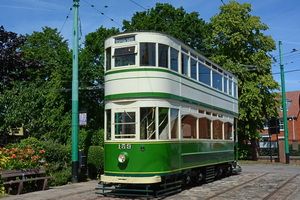
Where the Past Passes By
 Here you can see a unique project; the creation of a museum of street transport designed to show the development of mechanical transport over the best part of a century. The essence of transport is movement, so we are building a living museum where vehicles of yesteryear can be seen in action, where half-forgotten sounds of the past are brought back to life and where visitors can journey back in time by travelling on a few of the exhibits along the Museum’s streets. Many old vehicles seem ill at ease in a rural environment, so our aim is to develop a street scene of houses and shops, complete with authentic street furniture of bygone days, rescued by us from many parts of the country.
Here you can see a unique project; the creation of a museum of street transport designed to show the development of mechanical transport over the best part of a century. The essence of transport is movement, so we are building a living museum where vehicles of yesteryear can be seen in action, where half-forgotten sounds of the past are brought back to life and where visitors can journey back in time by travelling on a few of the exhibits along the Museum’s streets. Many old vehicles seem ill at ease in a rural environment, so our aim is to develop a street scene of houses and shops, complete with authentic street furniture of bygone days, rescued by us from many parts of the country.
At Carlton Colville we have one of the widest ranges of preserved vehicles of any museum, and further exhibits are still accepted from time to time, although restrictions on covered accommodation necessarily confine these mainly to items of local or specific historic interest.
Our story began back in 1962 when four local tramway enthusiasts rescued the body of an old Lowestoft tramcar, no. 14, from its use as a summerhouse at Gunton. From this grew the idea of forming a transport museum, and as a result the East Anglia Transport Museum was founded on its present site in 1965. A Society was formed with the object of developing and running the Museum and started off with a few old vehicles which had been either donated or loaned, but with no other assets whatsoever. The huge task lay ahead of transforming a disused meadow,into a museum with depots, stores, workshops, administrative offices, refreshment facilities and toilets, not forgetting roads, tram tracks, overhead wiring for trams and trolleybuses, and a light railway.
The Tramway
The museum is very fortunate to have a tramline that is relatively compact and easy to manage, whilst being long enough for our visitors to fully appreciate a ride by vintage tram. After travelling along the museum street, trams turn off onto our wonderfully atmospheric woodland tramline, terminating at Hedley Grove picnic area. Visitors may return to the museum on either the same or another tram, or take a leisurely stroll along the woodland path, from where unique views of the trams in a woodland setting can be seen.
The Trolleybus Route
On 10th January 1971 history was made when London Transport trolleybus 1521 was the first of its kind to run under trolleybus overhead in a museum anywhere in the country. Now the museum circuit is probably the most complex of its kind in the country, in terms of the number of possible movements constrained by overhead wiring. In July 2008 the amount of roadway available for trolleybus operation was almost doubled, allowing a circular route around the site to be taken. Additionally, the museum has always been known among enthusiasts as the ‘home’ of the preserved London trolleybus, with No’s 260, 796, 1201 and 1521 in residence.
The East Suffolk Light Railway
This is the title given to our 2ft gauge railway which opened in 1973 to recreate a typical light railway of years gone by. It winds its way along the northern perimeter of the Museum between the main station at Chapel Road, and Woodside, the furthest point of the trolleybus route.
Motive power is provided by two Simplex industrial locos, previously working at Duxford Imperial War Museum, and a Ruston engine, which prior to its work at the museum, was in use with Portland Cement at Lewes, Sussex. In addition is a 1934 Simplex loco which came to the museum from the King’s Lynn quarry of British Industrial Sand. Passenger rolling stock comprises an 18 seat enclosed bogie carriage built on a chassis that is now over 100 years old, and a four-wheeled brake van, built on what used to be a 1934 Simplex loco. The railway is home to some of our most interesting large-scale artifacts’ including the only remaining piece of the 3ft gauge Southwold Railway closed in 1929 – a luggage van originally built in 1885.
Exhibition Halls
The museum has a number of exhibition halls filled with historic vehicles and artifacts where visitors can come and view part of our extensive collection. With displays focussed on cars, commercial vehicles, electric vehicles and steam, there is surely something to interest everyone.
Folder
a bob mortlock website

